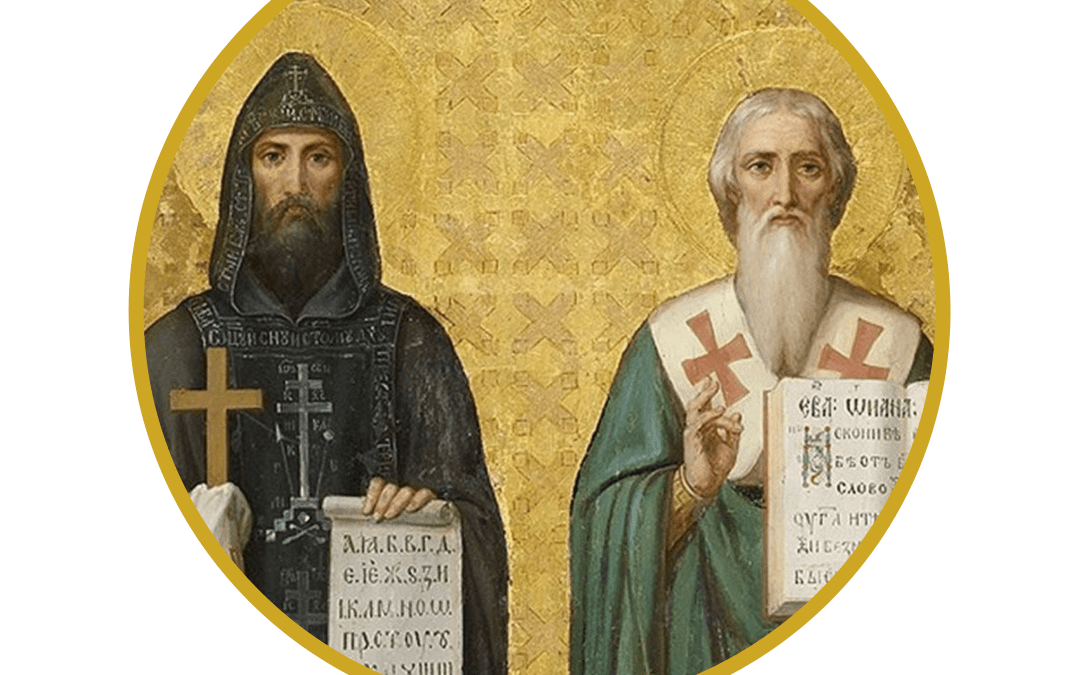
by popadmin | Feb 13, 2022 | CIC Saint Writeups
14 February: Feast of Saints Cyril and Methodius. Today, the Church honors two brothers known as the “Apostles of the Slavs” for their tireless work in spreading the Gospel throughout Eastern Europe. Born into a prestigious senatorial family in Thessalonica, in 815 and 826, Cyril and Methodius received an excellent education but renounced their wealth and status. They chose instead to become priests. Both were in a monastery when authorities from the Khazar Empire sent for a Christian missionary. Cyril was chosen and Methodius accompanied. They converted many. By the middle of the ninth century, Prince Rastislav of Moravia wrote to the Byzantine Emperor Michael III, asking for teachers who could teach his people the Christian faith in their own language. Cyril and Methodius were chosen. When they set out on this missionary journey, letters of a new Slavonic alphabet were revealed to them in answer to prayer. Together, they invented the “Cyrillic alphabet” as a way to communicate the faith. They translated the Scriptures and the Liturgy into this Slavonic. They said of their alphabet, ‘Receive this gift, which is more precious and greater than all silver and gold and precious stones and all magnificent wealth’. The two labored in Moravia for years, achieving great success in spreading the Faith. Their Byzantine origins and use of the vernacular language caused German church officials to regard them with suspicion. However, after being summoned to Rome, they met with Pope Adrian II who warmly approved of their methods. Cyril and Methodius were commended by the pope for their missionary activity and ordained bishops. Yet Cyril would not return to Moravia; he died in Rome on February 14, 869. He is buried in the Basilica of San Clemente. Methodius returned to Moravia and labored as a missionary among the Hungarians, Bulgarians, Dalmatians, and in Carinthia. Falling again under suspicion, he returned to Rome and defended the use of the Slavonic language in the liturgy. The Pope bestowed upon him the dignity of archbishop. After his return to Moravia, Methodius spread the light of faith in Bohemia and Poland, and went to Moscow to establish the diocese of Kiev. He suffered imprisonment for three years under German critics; Pope John VIII managed to have Methodius freed and reinstated as archbishop. Pope John VIII continued to support Methodius’ use of the Slavic language, despite continuing controversy with the German church. Eventually, with the help of Greek priests, Methodius translated the whole Bible into the language that is known today as Church Slavonic. After a life spent spreading the Faith, Methodius died on April 6, 885. Both brothers are venerated in the Orthodox Church as saints with the title of “equal-to-apostles”. In 1880, Pope Leo XIII introduced their feast into the calendar of the Roman Catholic Church. In 1980, Pope St. John Paul II declared them co-patron saints of Europe, together with Saint Benedict of Nursia.
Saint Valentine: who was he?
Although hard to verify, legend states that Valentine, along with St. Marius, aided Christian martyrs during the Claudian persecution. Claudius issued a decree forbidding marriage, to increase army troops (believing single men better soldiers than married men). Valentine defied this decree and urged young lovers to come to him in secret to be married. Eventually he was discovered, arrested, and condemned to death. While in prison, Valentine befriended the jailer and his blind daughter. The daughter often him brought food and messages. Valentine was able to convert both father and daughter to Christianity. Legend says he also miraculously restored the daughter’s sight. The night before his execution, he wrote a farewell message to the girl and signed it affectionately “From Your Valentine,” a phrase that lives on today. He was executed on February 14, 273. The Martyrology says, “At Rome, on the Flaminian Way, the heavenly birthday of the blessed martyr Valentine, a priest. After performing many miraculous cures and giving much wise counsel he was beaten and beheaded under Claudius Caesar.” A valentine has become a universal symbol of friendship and affection shared on the anniversary of his death: St. Valentine’s Day.
(sources: Catholicnewsagency.com; catholicculture.org; Fr. Tim Pike, CMP; The Catholic All Year Compendium by K. Tierney)
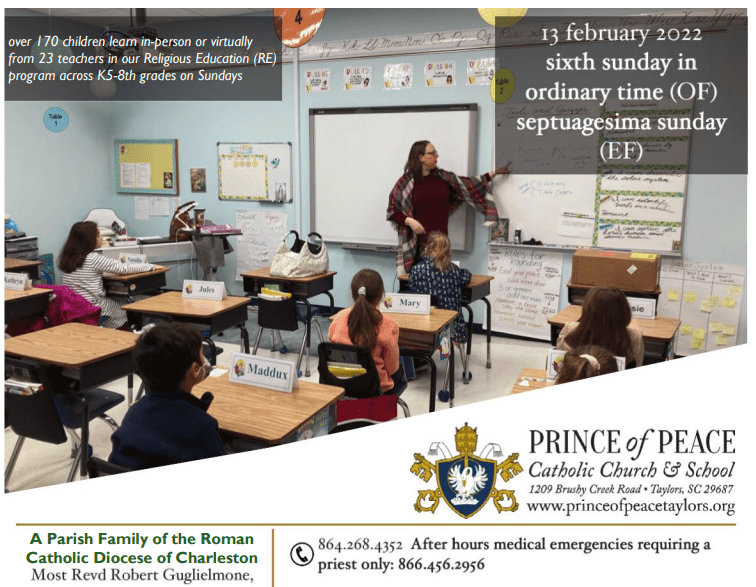
by popadmin | Feb 9, 2022 | Bulletin
Click to read this week’s bulletin: 13 February 2022. Plus, special insert of the 2021 Annual Report
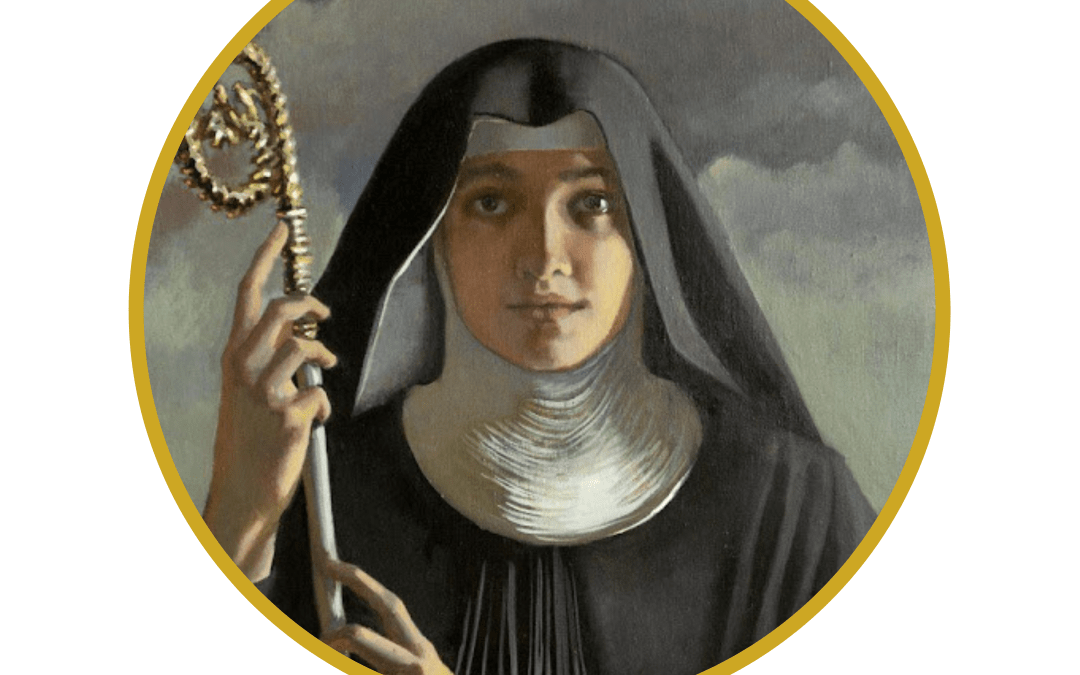
by popadmin | Feb 6, 2022 | CIC Saint Writeups
10 February: Feast of Saint Scholastica. Scholastica was the twin sister of Saint Benedict, the Patriarch of Western monasticism. She was born in Umbria, Italy, about 480. Under Benedict’s direction, Scholastica founded a community of nuns near the great Benedictine monastery Monte Cassino. Inspired by Benedict, from early youth Scholastica dedicated her life to seeking and serving God. In his Second Book of Dialogues, Pope St. Gregory described the last meeting between these holy twins: “His sister Scholastica, who had been consecrated to God in early childhood, used to visit with him once a year. On these occasions he would go to meet her in a house belonging to the monastery a short distance from the entrance. For this particular visit he joined her there and they spent the whole day singing God’s praises and conversing about the spiritual life. When darkness was setting in they took their meal together and continued their conversation until it was quite late. Then the holy nun said to him, ‘Please do not leave me tonight, brother. Let us keep on talking about the joys of heaven till morning.’ ‘What are you saying, sister?’ he replied. ‘You know that I cannot stay away from the monastery.’ The sky was so clear at the time, there was not a cloud in sight. “At her brother’s refusal Scholastica folded her hands on the table and rested her head upon them in earnest prayer. When she looked up again, there was a sudden burst of lightning and thunder accompanied by such a downpour that Benedict and his companions were unable to set foot outside the door. By shedding a flood of tears while she prayed, this holy nun had darkened the cloudless sky with a heavy rain. The storm began as soon as her prayer was over; thunder was already resounding as she raised her head. Realizing that he could not return to the abbey in this terrible storm, Benedict complained bitterly. ‘God forgive you, sister!’ he said. ‘What have you done?’ Scholastica simply answered, ‘When I appealed to you, you would not listen to me. So I turned to my God and He heard my prayer. Leave now if you can. Leave me here and go back to your monastery.’ This, of course, he could not do. He had no choice now but to stay. They spent the entire night together and both of them derived great profit from the holy thoughts exchanged about the interior life. The next morning Scholastica returned to her convent and Benedict to his monastery. Three days later as he stood in his room looking up toward the sky, he beheld his sister’s soul leaving her body and entering the heavenly court in the form of a dove. Overjoyed at her eternal glory, he gave thanks to God in hymns of praise. Then, after informing his brethren of her death, he sent them to bring her body to the abbey and bury it in the tomb he had prepared for himself. The bodies of these two now to share a common resting place, just as in life their souls had always been one in God.” Saint Scholastica died in the year 547. She is the patron saint of convulsive children, nuns, and for protection from rain and storms.
Ideas for celebrating this feast day:
- Tell your children about the “holy twins”: St. Scholastica and the love she had for her brother St. Benedict. Ask them how they can help one another become saints.
- Children can cut paper into the shape of doves to honor St. Scholastica. Decorate the dinner table with these doves. Make an Italian dinner in Scholastica’s honor.
- Look up St. Benedict’s Abbey of Monte Cassino. This videogives a virtual visit.
- Inspired by these holy siblings, learn how to prayerfully read Sacred Scripture in this article Lectio Divina. Click here for more on praying Lectio Divina from the USCCB.
- The need for prayer at this time in history is so great. Inspired by St. Scholastica, come pray the Liturgy of the Hours with your parish family! Sunday at 5pm; Matins/Lauds on M/Th at 7:40 and 8am, Vespers on T/F at 5:30pm.
“She was able to do more because she loved more.”—Saint Gregory the Great. May we all be inspired by St. Scholastica to hold love as the first rule of our lives.
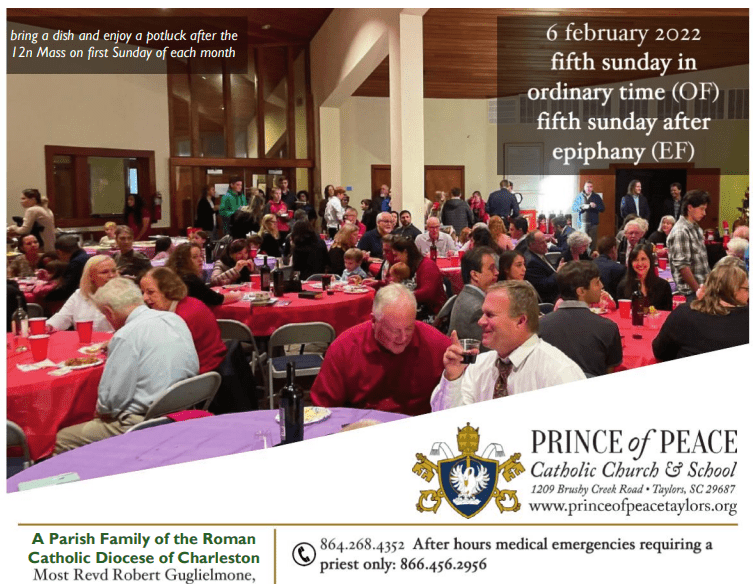
by popadmin | Feb 6, 2022 | Bulletin
Click to read this week’s bulletin: 6 February 2022
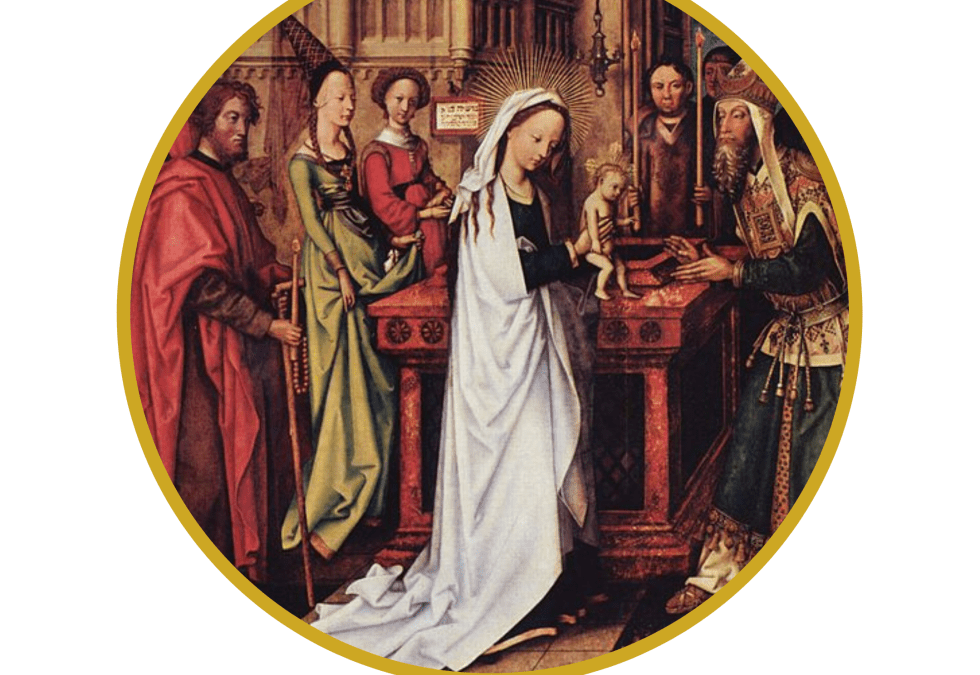
by popadmin | Feb 2, 2022 | CIC Saint Writeups
2 February: Feast of the Presentation of the Lord. Also known as Candlemas, this feast commemorates three distinct but related historical events in the life of the Holy Family. It marks the day when Mary and Joseph brought baby Jesus to the temple in Jerusalem, exactly 40 days after his birth. The Mosaic Law required them to consecrate their firstborn son to God (Exodus 13). Additionally, the law required Mary to submit to ritual purification forty days after childbirth (Leviticus 12:2-8). The ritual involved making a sacrificial offering in the temple. The Gospel of Luke tells us that as Mary and Joseph were poor, they took the option provided for those who could not afford a lamb, sacrificing “a pair of turtledoves, or two young pigeons” (Luke 2:22-24). Neither Mary (perfectly pure and conceived without sin) nor Jesus (God himself) were in need of being purified and consecrated to God; however, they submitted themselves in perfect obedience to God and to the Law of Moses. Our current church calendar focuses this day on the Presentation but in previous eras the Church highlighted the Purification of Mary. {There also used to be a Church custom of “churching” or blessing women forty days after childbirth. It reintroduced the woman to society after her period of recovery at home. Today, churching has disappeared as a custom and now blessing of the mother takes place at the baby’s baptism ceremony.} Today’s feast also commemorates the encounter in the temple between the Holy Family and Saint Simeon the prophet and Saint Anna the prophetess. This is the third and final infancy epiphany of Jesus (the first was to the Hebrew shepherds; the second to the Gentile kings; this third one to the elders of the Israelites). The next epiphany in the life of Jesus will be to the public, at his Baptism in the Jordan. Today’s feast is known by the title Candlemas because of the words of Saint Simeon when he met the child Jesus in the temple: “For my eyes have seen your salvation which you have prepared in the presence of all peoples, a light for revelation to the Gentiles, and for glory to your people Israel” (Luke 2:30-32). Jesus is the Light of the World, the Messiah who has come not just for the Jew but the gentile; not just the righteous, but the sinner. On this feast day, the Church blesses candles for use throughout the year (this has been a church tradition at least since the seventh century). Traditionally, families also bring their own candles to church to be blessed on this feast. The candles represent the fact that the light of the world is here; the light is coming into a dark world as the Church calendar progresses towards the brightness of Easter.
Ideas for celebrating this feast day:
- Go to mass and bring a stack of candles to be blessed for use over the next year! Prince of Peace has mass and blessing of the candles at 8:30am and 7pm on 2 February.
- If you are unable to go to mass, do a family Candlemas procession and prayer at home. Instructions here.
- Candlemas is known in France as “crepe day”. Make savory crepes for dinner (use whole wheat flour and fill them with ham, cheese, etc.) and sweet crepes for dessert (use white flour and top them with fruit, chocolate, whipped cream).
- A Candlemas tradition is to spend the day without electric lights – or at least to eat dinner only by candlelight (using your blessed candles!)
- Say a family rosary by candlelight; the Presentation in the Temple is one of the Joyful Mysteries.
- Meditate on the constant fiatof Our Lady of Sorrows, who embraced the will of God even as Simeon predicted that a sword would pierce her heart.
- If you haven’t taken down your Christmas decorations yet, today’s the day! Candlemas marks the very end of the liturgical season of Christmas.
- Read this articleto learn about the connection between Candlemas and Groundhog Day.
- Read Fr. Butler’s article: The Purification, Commonly called Candlemas-Day and Pope St. JP II’s article: Presentation Prefigures the Cross.
(Sources: catholicculture.org; Catholic All Year Compendium by K. Tierney; Catholicstraightanswers.com)
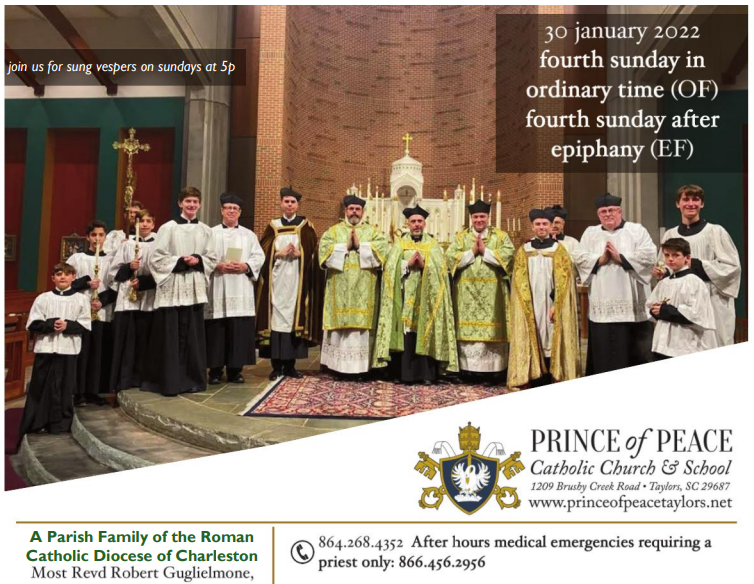
by popadmin | Feb 2, 2022 | Bulletin
Click to read this week’s bulletin: 30 January 2022






Recent Comments